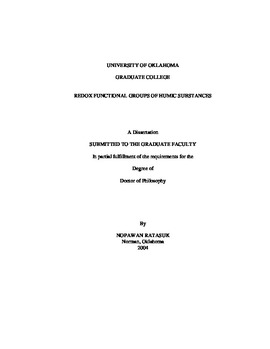| dc.contributor.advisor | Nanny, Mark A., | en_US |
| dc.contributor.author | Ratasuk, Nopawan. | en_US |
| dc.date.accessioned | 2013-08-16T12:19:34Z | |
| dc.date.available | 2013-08-16T12:19:34Z | |
| dc.date.issued | 2004 | en_US |
| dc.identifier.uri | https://hdl.handle.net/11244/811 | |
| dc.description.abstract | A new analytical technique based on palladium (Pd) and H2 catalytic system showed significant potential as a useful method for reliably assessing redox sites in humic substances. The technique identifies redox sites as a function of their resistance to the hydrogenolysis process. The test system consists of catalytic reduction process, the measurement of electron carrying capacity, and air oxidation. The extent of hydrogenolysis, which occurs during the catalytic reduction, can be controlled by pH and the type of catalyst used in the system. Verification of the reversibility of the redox sites is also permitted due to the use of a removable catalyst that allows the test to be repeated. Eight quinone compounds and fourteen humic substance samples were examined using this technique. The tests with quinone compounds demonstrated that hydrogenolysis occurring in the pH 6.5-Pd/Al2O3 redox system effectively removed quinone moieties in all model compounds. When the system's pH was increased to 8, the extent of hydrogenolysis became less intense. Quinones with an electron withdrawing substituent were left intact. As hydrogenolysis was further compromised by removing Al2O3 from the system, quinones without substituents and quinones with adjacent electron donating functional groups also remained intact. At that point, only quinones with an electron donating substituent located far away in a separate conjugated system suffered hydrogenolysis. The humic substance samples' tests showed that six landfill leachate humic substances, which were highly aliphatic, did not have redox sites. Eight other humic substance samples were capable of shuttling electrons, even in the pH 6.5-Pd/Al2O3 redox system, which had removed their quinone redox sites. The technique showed that redox sites in humic substance samples include both nonquinone (NQ) and quinone groups. Redox sites in the NQ group were responsible for 21%--56% of the electron carrying capacity (ECC) of the samples. The technique divided redox sites in the quinone group into two subgroups. The first subgroup includes redox sites with a neighboring electron withdrawing substituent which was liable for 13%--58% of the ECC. The second subgroup contains redox sites characterized by having an adjacent electron donating substituent and were accountable for 8%--50% of ECC. | en_US |
| dc.format.extent | xiii, 123 leaves : | en_US |
| dc.subject | Hydrogenolysis. | en_US |
| dc.subject | Humic acid. | en_US |
| dc.subject | Electron transport. | en_US |
| dc.subject | Environmental Sciences. | en_US |
| dc.title | Redox functional groups of humic substances. | en_US |
| dc.type | Thesis | en_US |
| dc.thesis.degree | Ph.D. | en_US |
| dc.thesis.degreeDiscipline | School of Civil Engineering and Environmental Science | en_US |
| dc.note | Adviser: Mark A. Nanny. | en_US |
| dc.note | Source: Dissertation Abstracts International, Volume: 65-10, Section: B, page: 5050. | en_US |
| ou.identifier | (UMI)AAI3150965 | en_US |
| ou.group | College of Engineering::School of Civil Engineering and Environmental Science | |
